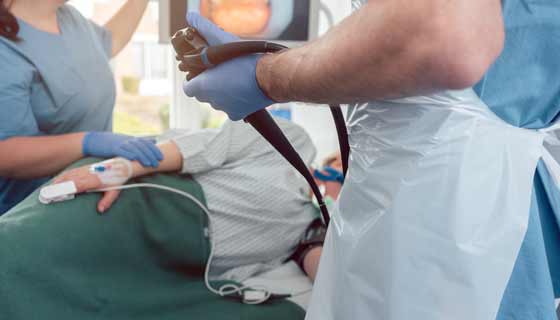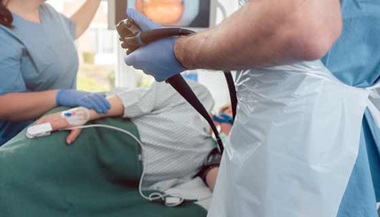Transoral Incisionless Fundoplication (TIF)
If you have persistent symptoms of gastroesophageal reflux disease (GERD), your gastroenterologist may recommend a procedure called transoral incisionless fundoplication (TIF) to reconstruct the valve between your stomach and esophagus (the passageway between your mouth and stomach).
What You Need to Know
- TIF is an endoscopic procedure. Doctors use a special TIF device along with an endoscope (a flexible, tube-like instrument inserted into the mouth that can help doctors see inside the body).
- The TIF device is equipped with grippers and fasteners, which help the doctor repair or re-create the valve so it becomes a better barrier against acid reflux.
- Because TIF does not involve an incision (cut) as does traditional open or laparoscopic surgery, it may mean a faster, less painful recovery.
- TIF is performed by gastroenterologists (doctors trained to diagnose and treat problems in the gastrointestinal [GI] tract) or surgeons.
What is a TIF procedure?
Transoral incisionless fundoplication is a minimally invasive procedure to treat acid reflux, also known as heartburn, and other symptoms associated with chronic gastroesophageal reflux disease (GERD). These symptoms are caused by a malfunctioning valve that allows stomach acid into the esophagus.
- Fundoplication means folding of the fundus, the tissue at the top of the stomach. By folding the fundus around the opening between the stomach and esophagus, a gastroenterologist reinforces this area to prevent stomach acid from coming up into the esophagus. Fundoplication helps create a new barrier to reflux from the stomach. It can be done with an endoscope (the TIF procedure) or with minimally invasive laparoscopic surgery (such as Nissen fundoplication).
- Transoral means the procedure is done through the mouth without any external incisions.
Concomitant Transoral Incisionless Fundoplication (cTIF): An Innovative Anti-reflux Procedure
Who can benefit from the TIF procedure?
A gastroenterologist may recommend transoral incisionless fundoplication to treat a patient who has GERD symptoms that are not managed well with other treatments such as antacids and drugs called proton pump inhibitors (PPIs). These medications do not work well in some people. Also, although not yet confirmed by research, there are increased concerns about side effects of PPIs, especially with long-term use. Repairing the esophagus valve with TIF can be an alternative way to ease GERD symptoms.
TIF Procedure Versus Nissen Fundoplication
TIF is a less invasive procedure than Nissen fundoplication, the surgery traditionally performed to repair the valve.
During Nissen fundoplication, doctors make an incision in the abdomen and then wrap the top of the stomach all the way around the esophagus to re-create a valve. This wrap acts like a tight belt. This is an invasive procedure that can cause complications, including:
- Trouble swallowing
- Difficulty eating (this can last for several months)
- Belching (burping) and bloating due to trapped air in the stomach
- Hernia at the incision location
- Valve failure within eight to 10 years, requiring a second procedure
Doctors can also use TIF to repair a valve previously created with Nissen fundoplication. A valve created with TIF is typically longer than and not as tight as a valve made with the Nissen procedure. These factors contribute to fewer side effects after TIF.
Transoral Incisionless Fundoplication (TIF) FAQ's | Marcia Canto, M.D.
Preparing for the TIF Procedure
Measuring pH in the Esophagus
Before the TIF procedure, you will receive wireless pH monitoring (called a Bravo capsule test) to evaluate the severity of GERD and to ensure you are a good candidate for the procedure. This test measures how often and how long stomach acid is moving into your esophagus (reflux) over a 48-hour or 96-hour period. Using an endoscope, the gastroenterologist places a capsule containing a small chip in the lower part of your esophagus. The chip records acid levels at that location and transmits the information wirelessly to a recording device you wear on a belt. Your doctor downloads this data and uses it to assess the severity of the reflux.
Assessing a Hiatal Hernia
Your doctor may perform an upper endoscopy and order a video X-ray that can show the functioning of the esophagus and the valve. These tests help determine the presence and severity of a hiatal hernia (stomach pushing through the diaphragm), which can contribute to your symptoms.
Small hiatal hernias can often be repaired during the TIF procedure. Hiatal hernias larger than 2 centimeters cannot be treated with an endoscopic TIF procedure alone and may need to be repaired before TIF, during a laparoscopic surgical procedure called cTIF (TIF with a concomitant hiatal hernia repair).
Other Steps to Prepare for TIF
- Do not eat or drink for 12 hours before the procedure, to make sure there are no traces of food in your esophagus.
- Tell your doctor if you have any allergies.
- Follow your doctor’s instructions about if, when and how to take your medications and supplements.
What happens during the TIF procedure?
TIF takes about 30 to 45 minutes to perform, but you may be asked to arrive an hour and a half before the start of the procedure. During the procedure, the gastroenterologist and the TIF team will:
- Give you an IV with medication to make you sleepy
- Insert a special tissue-molding TIF device into your esophagus through the mouth
- Pass a high-definition endoscope into your mouth through the TIF device, and your doctor will observe the images on a screen
- Advance the TIF device with the endoscope into the stomach, with the endoscope pointing toward the top of the stomach so the doctor can see the place where the esophagus and stomach meet
- Correct the hiatal hernia, if you have one, by applying suction and re-positioning the part of the stomach protruding through the diaphragm
- Use the TIF device to grasp the end of your esophagus, bring it down and wrap the tissue in the top portion of the stomach about three-quarters of the way around the end of the esophagus
- Secure the folded tissue with durable plastic fasteners that remain in the body
- Remove the TIF device and endoscope through the newly created valve and out of the mouth
TIF Procedure for GERD | Frank's Story
Recovery After the TIF Procedure
After the procedure, you may stay in the hospital overnight or you may be able to go home the same day if you feel well. Your gastroenterologist will discuss the results of the procedure and follow-up care before you leave.
After TIF, you may need to:
- Take antibiotics for two or three days and medications for symptom relief if you need them
- Drink clear liquids only for the first 24 hours, then drink full liquids for one week, then eat soft foods for one week and resume your regular diet during the third week, avoiding breads and meats for a month
- Gradually phase out PPIs and other GERD medications as instructed by your gastroenterologist
- Stay away from vigorous physical activity for three weeks and avoid lifting anything heavier than 5 pounds, then resume aerobic exercise after three weeks but avoid lifting anything heavier than 50 pounds
TIF Procedure Success Rate
Multiple national studies have shown that the TIF procedure is performed successfully in up to 99% of patients, with just 2% experiencing issues during or after the procedure, such as a tear or internal bleeding.
For a large number of patients, TIF provides significant GERD symptom relief and improved quality of life. Most patients (91%) also experience reduction in hiatal hernia and many (89%) are able to stop taking PPI medicine.
Symptom relief after TIF typically lasts from eight to 10 years, which is similar to relief in most cases of Nissen fundoplication treatments. When the GERD symptoms return, some people may need to repeat TIF, resume taking PPIs or explore other treatments.
TIF Procedure Complications, Risks and Side Effects
Transoral incisionless fundoplication is generally safe. There is a slight chance of bleeding, but side effects are usually minor and temporary. They can include:
- Sore throat
- Shoulder pain
- Chest pain









